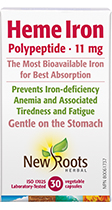Heme Iron: It’s All a Matter of Digestion…
Anemia and Advantages of Heme Iron Supplementation
Take a deep breath, because without iron, there is no cellular respiration! This trace metal allows oxygen to travel from lungs to every cell in the body, thanks to hemoglobin that is found in our red blood cells. Apart from being the cofactor in many enzyme reactions, it also stimulates the immune system and reduces stress. It is included in most foods, and the largest amount is found in animal products: blood sausage, offal, crustacean, beef, fish, yolk, rabbit… In vegetables, it’s plentiful in whole grains, sesame, cocoa, raw spinach, legumes, etc. Since it’s water-soluble, you can add it to your soup. As well, keep in mind that tannins (tea, coffee), zinc (antagonist), calcium, as well as certain fibres and medicine may reduce its assimilation.
There is Iron, and Iron...
Absorption of iron happens in the duodedum and jejunum, the first two parts of the small intestine. Its bioavailability depends on its form: heme iron (from blood, connected to hemoglobin and myoglobin) makes just 6% of the intake, as opposed to the mineral nonheme iron from vegetables. The bioavailability of the nonheme iron ranges between 1 and 10%, a lot lower than that of heme iron, which is close to 40%. The major advantage of heme iron is that it is easily digested, especially from a meal. On the other hand, the digestion of nonheme iron is more demanding, consists of more steps, and must be released from food by the stomach’s hydrochloric acid, which reduces ferric iron Fe3+ to ferrous iron Fe2+, for ease of assimilation. In fact, the “pandemic” of hypochlorhydria (disturbance in production of hydrochloric acid) is usually wrongly treated using antacids, that only make the problem worse.
Iron Imbalances
Anemia caused by martial (iron) deficiency is common in women in their reproductive age and in children less than 3 years old. The WHO estimates that it affects 800 million people worldwide. Chronic blood loss (abundant periods, ulcers, hemorrhoids…), pregnancy, badly adapted vegetarian and vegan diets, excessive training (strains and sweating), and bad digestion all contribute to iron-deficiency anemia. The sequestration of iron by leucocytes deprives the body during infection, cancer, and inflammatory diseases.
Inversely, an excess of iron oxide could become harmful if it exceeds your RDA (Recommended Daily Allowance), which depends on the person and their situation. These cases represent a rare genetic disorder called hemochromatosis or overdose by supplementation. Read the labels well, and don’t take too many iron-containing supplements!
Which form should I choose?
A food supplement that contains nonheme iron could eventually cause symptoms such as constipation, diarrhea, nausea, and pain. At recommended doses, heme iron does not have any side effects. In addition, active forms of vitamins C, B9, and B12; copper; and manganese accelerate the digestion of iron. So, look for a supplement that contains all this.
If you need iron, there is no doubt that you will benefit from its highly absorbable heme form.
Recommendation: Iron supplementation should be prescribed by a health-care practitioner following a medically diagnosed deficiency. For the proper use, consult your doctor or your naturopath.
 Guillaume Landry, MSc, Naturopath
Guillaume Landry, MSc, Naturopath
A native of the Jura mountains of eastern France, he shares
his passion for the wonders of nature and natural medicine.

 Stores
Stores
